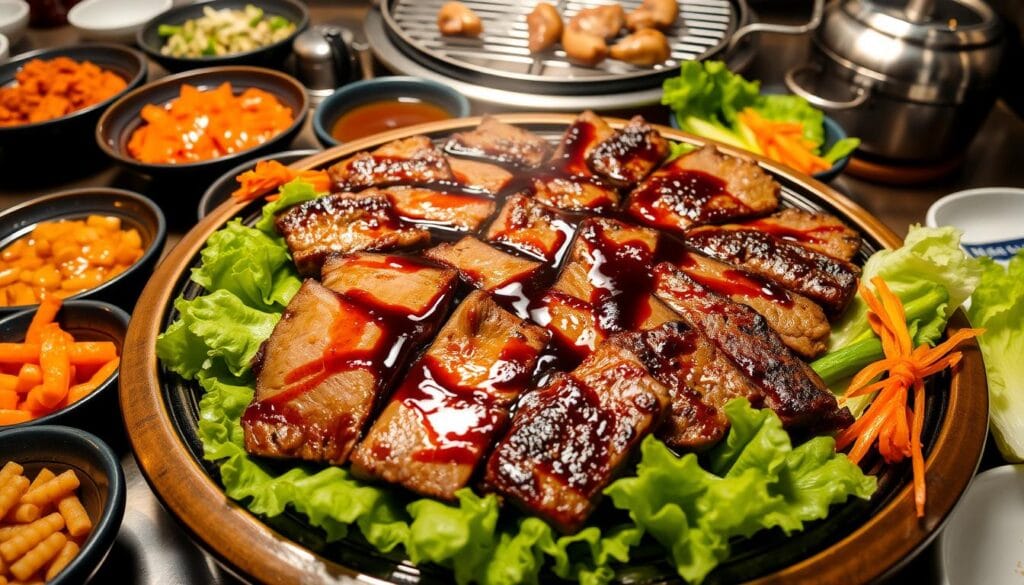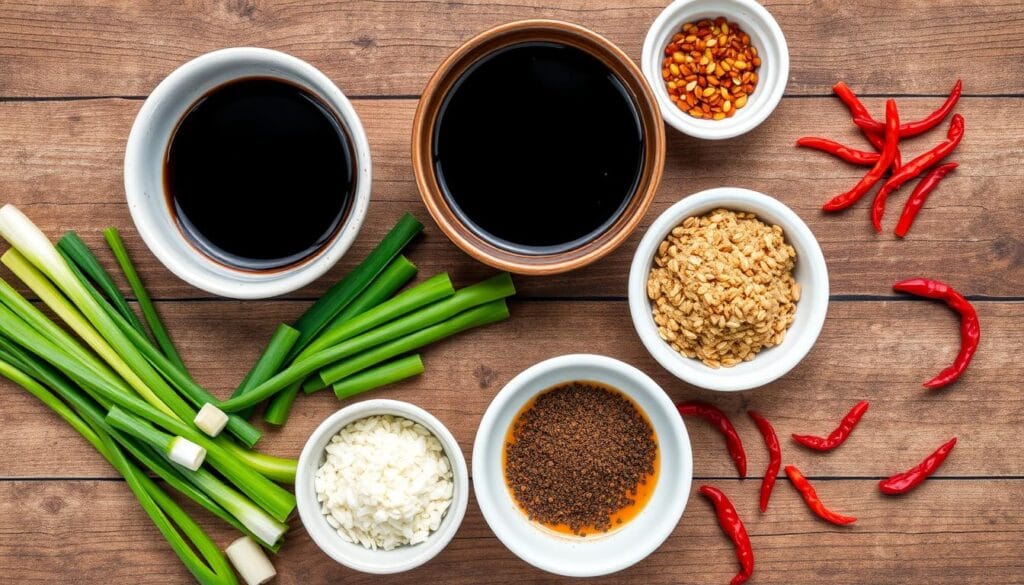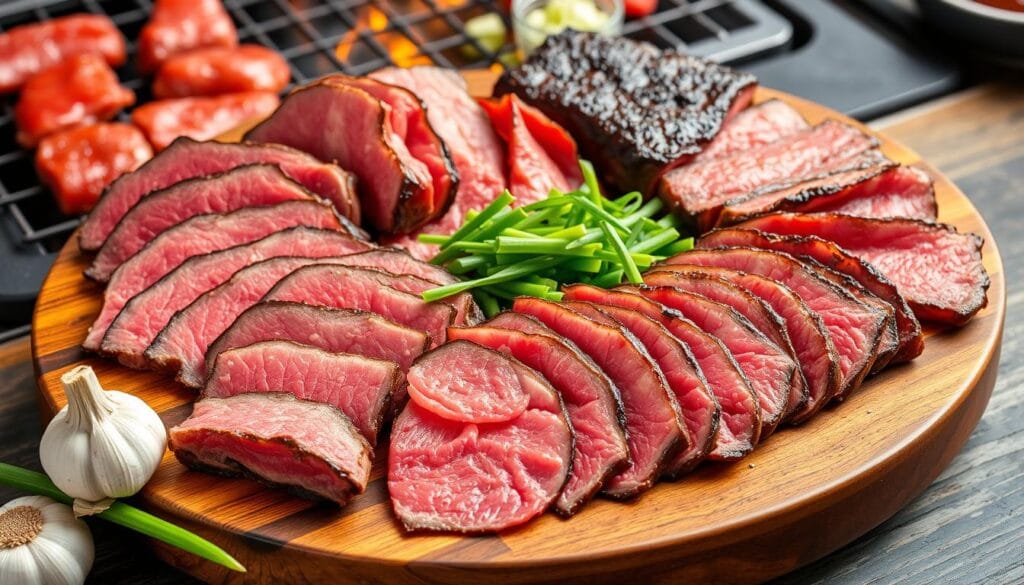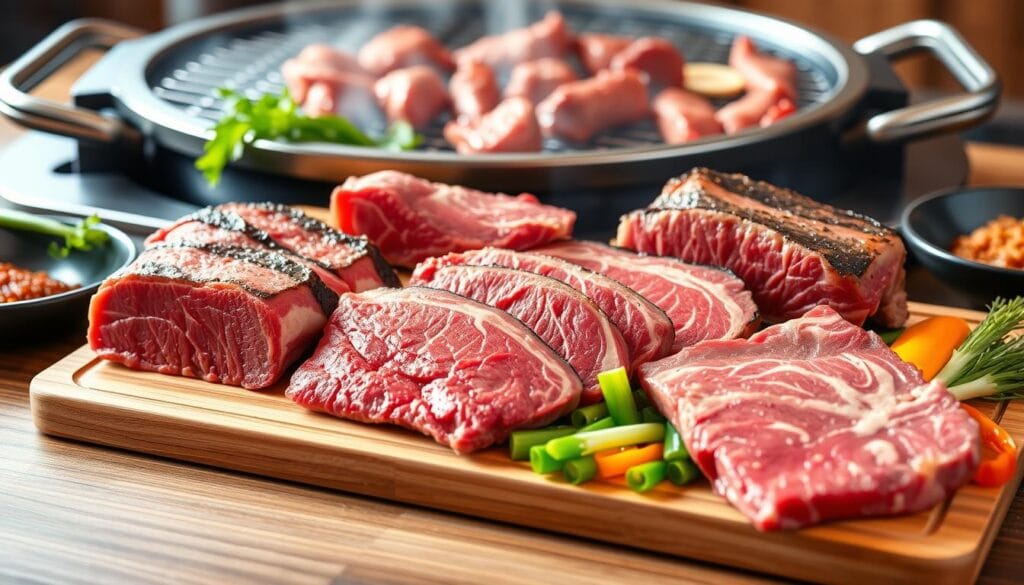I love cooking at home and trying new recipes. Beef bulgogi from Korea is one of my favorites. It’s known for its rich flavors and tender meat. But, the secret to great bulgogi is choosing the right beef.
My grandma used to make the best bulgogi. She picked the tenderest beef and marinated it just right. I learned that different cuts of beef make a big difference in bulgogi.
Introduction to Beef Bulgogi
Beef bulgogi, or “fire meat” in Korean, is a favorite dish for many. It’s a mix of marinated and grilled beef, loved for its sweet and savory taste. If you’re wondering, what cut of meat is used for beef bulgogi, the answer often includes ribeye, sirloin, or chuck steak. These cuts are tender, flavorful, and perfect for this iconic dish.
What is Beef Bulgogi?
Beef bulgogi is a Korean classic. It’s made by marinating thin beef slices in a tasty sauce. Then, the meat is grilled or pan-fried until it’s just right. But what cut of meat is used for beef bulgogi? Thinly sliced ribeye, sirloin, or chuck steak is commonly preferred for its tenderness and ability to absorb marinade flavors.
The marinade has soy sauce, brown sugar, Asian pear, garlic, ginger, and sesame oil. These ingredients mix to create a sweet, savory, and aromatic flavor.
The Popularity of Bulgogi
Bulgogi has been loved in Korea for centuries. It first appeared in the 1st century AD. Over time, it became a favorite dish across Korea.
Now, beef bulgogi is enjoyed all over the world. It’s known and loved by many.
Key Ingredients for Bulgogi
- Thinly sliced beef (such as ribeye, sirloin, or chuck)
- Soy sauce
- Brown sugar
- Asian pear
- Garlic
- Ginger
- Sesame oil
When deciding what cut of meat is used for beef bulgogi, ribeye is often the top pick due to its marbling and tenderness. Sirloin and chuck steak also work well, offering great flavor at a lower price.
These ingredients make beef bulgogi special. The thin beef slices are tender. The marinade adds amazing flavors.

Understanding Bulgogi Flavors
Making the perfect bulgogi marinade is key to its flavors. The marinade has soy sauce, brown sugar, mirin, sesame oil, garlic, onion, ginger, and Asian pear. These ingredients make the meat tender and full of Korean BBQ flavors.
Marinade Basics
The right mix of marinade ingredients is important. Use 1/2 cup soy sauce, 3 tablespoons brown sugar, 2 tablespoons mirin, and 1 tablespoon sesame oil for 1.5 pounds of beef. Add minced garlic, onion, and ginger for a great taste.
Flavor Profiles of Bulgogi
The secret to Korean BBQ flavors in beef bulgogi is sweet, savory, and umami. Brown sugar and mirin add sweetness. Soy sauce and garlic give a savory taste. Sesame oil and Korean pear add nuttiness and fruity sweetness.
Importance of Meat Quality
The quality of the meat is crucial for bulgogi. Choose tender cuts like ribeye or sirloin for the best taste. Thinly slicing the meat helps flavors penetrate and cook evenly. So, what cut of meat is used for beef bulgogi? Ribeye, sirloin, and chuck steak are highly recommended, but flank steak or brisket can also work if sliced thinly and marinated well.

Recommended Cuts of Meat for Bulgogi
Choosing the right meat is key for the perfect beef bulgogi. Ribeye, sirloin, and chuck steak are top picks. They offer great flavor and tenderness. If you’ve been asking, what cut of meat is used for beef bulgogi, these three cuts stand out as the most popular. Ribeye offers marbling, sirloin provides balance, and chuck steak is affordable and flavorful. For tips on tenderizing tougher cuts like cube steak, visit how to cook cube steak so it’s not tough.
Ribeye: A Tender Choice
It is the best for bulgogi because it’s so tender and marbled. It’s like butter in your mouth. The rich beef flavor goes well with the sweet marinade.
Sirloin: A Budget-Friendly Option
Sirloin is a good choice if you want to save money. It’s not as tender as ribeye but still tasty. Slice it thin and marinate well for a tasty bulgogi.
Chuck Steak: Flavorful and Affordable
Chuck steak is another affordable option. It’s not as tender but has a deep beef flavor. Slice it thinly to make it tender and tasty.

It doesn’t matter which cut you pick. Just slice it thin against the grain. A good marinade and cooking method will make it tender and delicious.
Other Cuts to Consider
While ribeye and sirloin are popular for beef bulgogi, other cuts are great too. They offer different textures, and tastes, and can be cheaper. This makes your Korean BBQ better.
Flank Steak: A Unique Texture
Flank steak is a great choice for bulgogi. It’s lean and takes marinades well, making it chewy and tasty. Thinly sliced, flank steak bulgogi adds a special texture to your meal.
Top Round: Lean with Great Flavor
The top round is lean but full of flavor. It’s not as tender as some cuts, but its beefy taste is amazing. Thinly sliced and marinated right, it’s a tasty and affordable bulgogi option.
Brisket: For a Rich, Savory Taste
Brisket is perfect for a rich brisket Korean BBQ experience. Its fatty texture and savory flavor make bulgogi unforgettable. It takes longer to marinate, but the result is worth it.
Exploring different cuts for bulgogi is exciting. Remember, how you slice and marinate is crucial for a great dish. Try new things to make your Korean BBQ even better.

Preparing the Meat for Bulgogi
To get the perfect beef bulgogi, you need to prepare the meat right. This means paying attention to how you slice and marinate it. Doing it well will make your dish taste amazing.
Slicing Techniques
Freezing the meat for 15-30 minutes helps a lot. It makes the meat firm, so you can slice it thinly. Slice against the grain to make the meat tender and easy to chew.
Marinating for Best Results
Marinating the meat is key to making it taste better. Use a mix of soy sauce, vinegar, sugar, sesame oil, garlic, ginger, and red pepper flakes. Let it marinate for at least 4 hours, or even better, overnight.
Marinating for a long time lets the flavors soak into the meat. This makes the beef tender and full of flavor. Marinating overnight is the best way to get these results. For more marinating ideas, check out our guide on Lipton Onion Soup Meatloaf Recipe, which uses marinades for rich flavor.
Cooking Methods to Use
You can cook beef bulgogi in many ways. Grilling gives a smoky taste, while pan-frying adds a smoky flavor too. Broiling is another good option.
It’s important to cook the meat in batches. This prevents it from steaming, which can ruin the texture and flavor. You want the outside to be crispy and the inside to be juicy.
Cooking Methods for Bulgogi
Choosing the right cooking method is key to perfect beef bulgogi. You can grill it traditionally or pan-fry for a quick fix. Each method has its perks. Let’s dive into how to make your bulgogi the best it can be.
Grilling: The Traditional Approach
Grilling is the classic way to cook Korean BBQ bulgogi. It caramelizes the meat’s sugars, giving it a tasty crust. This method adds a deep flavor that’s true to bulgogi. Slice the meat thin and marinate well before grilling at high heat for a few minutes each side. For grilling tips, you might also enjoy Boneless Beef Short Ribs Recipe, perfect for outdoor barbecues.
Pan-Frying: Quick and Easy
Pan-frying bulgogi is a quicker option. It cooks in its juices, making it tender and juicy. Heat a skillet or cast-iron pan over high heat, add oil, and sear the bulgogi for a couple of minutes on each side. This method keeps the meat tender and adds a nice crust.
Broiling: A Delicious Alternative
Broiling is a great choice if you can’t grill. It sears the meat like grilling, giving it a charred edge and tender inside. Place the bulgogi on a broiler-safe tray or baking sheet. Broil for a few minutes on each side, watching closely to avoid overcooking.
No matter the method, high heat and quick cooking are crucial. They keep the meat tender and let the flavors stand out. Try different methods to find your favorite way to cook bulgogi at home.
Pairing Side Dishes with Bulgogi
No Korean barbecue is complete without tasty side dishes, called Korean banchan. These dishes balance the rich taste of bulgogi. They also add texture and color to your meal.
Popular Korean Side Dishes
Kimchi is a must-try. It’s a tangy, spicy, and sour cabbage dish. Other favorites include pickled radish, seasoned spinach, and sautéed bean sprouts. Each dish brings its own taste and health benefits.
Rice and Noodles: Essential Companions
Rice is key in any Korean meal. It’s perfect for soaking up the juices of bulgogi. For something more filling, try japchae, a sweet potato noodle dish. It pairs well with bulgogi for a great mix of flavors and textures.
Vegetables for Balance
- Radish chips or Korean potato salad add a nice crunch.
- Soybean sprout salad and stir-fried zucchini offer a light contrast to bulgogi.
- Grilled or sautéed vegetables, like onions and carrots, blend well with bulgogi.
Pairing bulgogi with Korean banchan, rice, noodles, and veggies makes a great Korean BBQ at home.
Serving Suggestions
When serving beef bulgogi, how you present it matters a lot. This Korean dish is often served family-style. It’s placed on a big platter with tasty Korean BBQ garnishes and sides.
How to Present Bulgogi
Start by putting the bulgogi in the middle of the table. This makes it easy for everyone to grab some. Add banchan (Korean side dishes) around it. These can be kimchi, seasoned spinach, pickled radish, or lettuce for wraps.
Traditional Korean Table Setting
- Serve the bulgogi on a large, shallow platter or dish.
- Arrange the banchan around the bulgogi in a circular pattern, creating a visually appealing spread.
- Provide individual bowls of steamed white rice, which serves as the perfect foil to the savory bulgogi.
- Include small dipping dishes filled with soy sauce, sesame oil, and gochujang (Korean chili paste) for added flavor.
Adding Garnishes for Flavor
To make the Korean BBQ look and taste better, add some garnishes. Sprinkle toasted sesame seeds and green onions on top. These add a nice crunch and aroma.
You can also serve the bulgogi in bowls or use it in sandwiches, tacos, or wraps. It’s a versatile dish that can be enjoyed in many ways.
Troubleshooting Common Issues
Cooking bulgogi can sometimes be tricky. But, with a bit of troubleshooting, you can fix any problem. This way, you’ll enjoy the perfect Korean BBQ at home. Let’s look at some common issues and how to solve them.
Tough Meat: Causes and Fixes
If your bulgogi is tough, there are a few reasons. The wrong meat cut, too thick slices, or overcooking can make it chewy. To get tender bulgogi, use ribeye or sirloin and slice thinly against the grain. Quick cooking over high heat also helps keep it juicy.
Maintaining Consistent Flavors
Flavor issues can happen with bulgogi. This is often due to different marinades or times. To get consistent flavors, use the same marinade recipe and marinating time. Stick to a 24-hour marinating time and the right mix of soy sauce, sugar, and sesame oil.
Fixing Over-Marinated Meat
Too much marinating, especially with acidic ingredients, can make bulgogi soft. To prevent this, marinate for no more than 24 hours. Also, use less acidic ingredients in the marinade. This way, you’ll get the right texture every time.
By solving these common bulgogi problems, you’ll make delicious Korean BBQ at home. Learn to fix tough and over-marinated meat. Your family and friends will love your bulgogi in no time.
Conclusion
Ribeye and sirloin are the best for beef bulgogi. They have the right mix of tenderness and flavor. But, you can also try chuck steak or flank steak to find what you like best.
Recap of Best Cuts
Ribeye and sirloin are top picks for bulgogi. They are known for their marbling and tenderness. These cuts give the dish its signature texture and flavor.
When picking your meat, choose well-marbled pieces. They will get even tastier when cooked.
My Favorite Preparation Tips
Thinly slice the meat against the grain. Marinate it for at least 4 hours, or better yet, overnight. This lets the flavors soak in.
When cooking, use a hot pan or grill. This keeps the meat tender. Try adding sesame seeds and green onions for extra flavor.
Encouragement to Try Bulgogi at Home
Making bulgogi at home is a great way to enjoy Korean food. With a little practice, you can make it just like in restaurants. So, give it a try and enjaoy the amazing flavors and smells.

